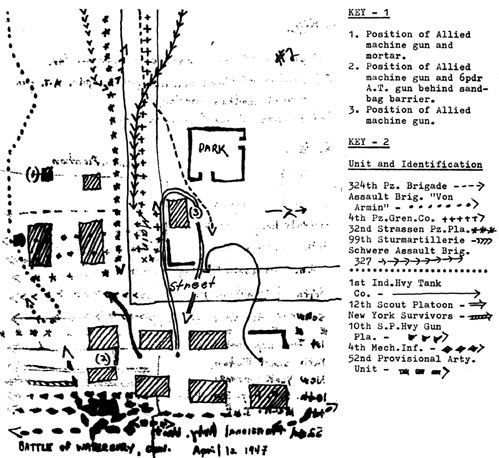 The morning of the Second Battle of Bridgeport dawned cold and rainy. The landscape around
Bridgeport was dotted with the wrecks of the many knocked-out tankst both Allied and Axis.
The morning of the Second Battle of Bridgeport dawned cold and rainy. The landscape around
Bridgeport was dotted with the wrecks of the many knocked-out tankst both Allied and Axis.
During the night both sides brought up troops and equipment. The Allies were determined to finally push the Germans out of Bridgeport. The Germans were equally determined to smash the Allies renewed attack upon the town.
The heavy curtain of rain which separated the two enemy forces aided both sides in planning their troop dispositions. The German commander attempted to conceal his forces totally in the town, behind buildings. The German second-in-command argued for the establishment of a strong armoured force on the perimeter of the Axis defences. The Commander-in-Chief preferred to keep the bulk of his forces in town, but he allowed the establishment of a picket line of four Pzkpfw IV H tanks on the perimeter.
The Allied commander established his forces in this manner: he placed his heavy and medium tanks in a long line in front. The scout cars were deployed on the right flank. The Allied artillery was disposed out of the German line of sight.
Just before the Allied attack began, the curtain of rain lifted. Only then did the German commander see the chilling sight of the Allied tank line sweeping toward the token four Pzkpfw IV's. These four mediums put up an admirable fight, but were literally overwhelmed by the Allied superiority of numbers.
The German commander saw his error, but the time has passed for its correction. He had six half-tracks (Schwerewehnmachtschlepper type) with Nebelwerfers for his artillery element. He hid these behind buildings and fired them in batteries of 3.
The Allied armoured line advanced closer and closer to the Axis positions. This advance was becoming more and more costly, as the Nebelwerfers knocked out one or two Allied tanks per salvo. In one salvo, four Allied vehicles were squashed.
While the tanks advanced the Allied artillery sniped at the few German vehicles which dared to show themselves.
As all this transpired, the undetected Allied right flank reared into the outskirts of Bridgeport. From this position they could see down the towns streets, where the enemy vehicles were hidden. They began to call down accurate and devastating artillery fire on the 3erman troops. The few Allied tanks which were left attacked the left flank. One M36 Jackson which had its gun damaged drove around the town, sseking targets for the artillery.
The accuracy of the Allied artillery provided the turning point in this battle. In one salvo the guns knocked-out two Nebelwerfers, and in the next salvo, the remaining four. Thus the German artillery was effectively and permanently silenced. From this point on the battle slowed into a game of hide-and-seek between the Allied artillery and the Axis armour. Gradually the latter lost out, and the Allies took Bridgeport.
After losing three battles in quick succession in the North, the German Commander-in-Chief decided to try his luck in launching his campaign in the South.
The Allied capacity for fighting and tactics was a rude shock for the Wehrmacht, and the bloody Northern campaign provided lessons which the Germans would not forget.
First Battle of Bridgeport: April 12, 1947
Back to Table of Contents -- Wargamer's Newsletter # 117
To Wargamer's Newsletter List of Issues
To MagWeb Master Magazine List
© Copyright 1971 by Donald Featherstone.
This article appears in MagWeb.com (Magazine Web) on the Internet World Wide Web.
Other articles from military history and related magazines are available at http://www.magweb.com